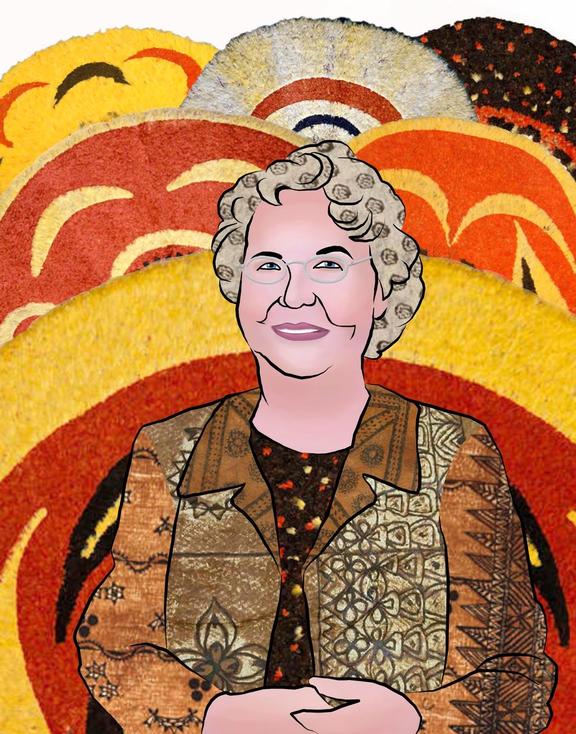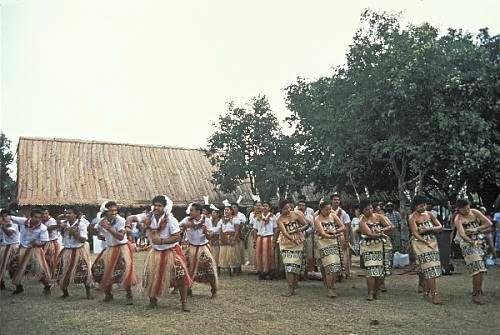The life and legacy of Adrienne Kaeppler Featured
 American anthropologist Adrienne Lois Keppler (Right) with teh Queen of Tonga HRH Nanasipau'u Tuku'aho
American anthropologist Adrienne Lois Keppler (Right) with teh Queen of Tonga HRH Nanasipau'u Tuku'aho
12 March, 2022. Tributes have flowed for American anthropologist Adrienne Lois Keppler, a leading scholar in Pacific art and dance, who passed away last weekend at the age of 86.

A portrait of Adrienne Kaeppler, Photo: Photo / Smithsonian Institution
The prestigious Smithsonian National Museum of Natural History in Washington D.C, published a tribute letter commending the Milwaukee-born academic, who produced more than 300 publications during her five-decade career.
"Her legacy will undoubtedly continue to inspire generations of new scholars for years to come," said Kirk Johnson, the museum's sant director.
Kaeppler spent most of her career working for the Smithsonian museum, where she was a curator in Pacific artefacts and an expert in the travels of Captain Cook.
She was a leading academic in Pacific Island ethnomusicology and collaborated with many prominent Polynesian traditional artists and leaders including Tonga's Queen Salote. Her research and travels covered the length of the Pacific, from Indonesia to Rapanui, where she collected insight into the intangible artefacts - the music, dance, and art.
"She was very much a pioneer and very innovative in that work early on," said Brian Diettrich, a friend of Kaeppler and senior lecturer in ethnomusicology at Victoria University of Wellington.
Last year, Diettrich helped produced a book called Perspectives in motion: engaging the visual in dance and music, which explored a compilation of Kaeppler's work.
"One of her contributions which was quite new, was really this approach to understanding dance forms, so she was applying linguistic analysis to the very small aspects of dance movement, and how to analyse and understand that," Diettrich saidd.
Tongan Choreography
Kaeppler moved to Hawaii from Milwaukee in 1959 to study Anthropology at the University of Hawai'i, where she quickly excelled, earning a Masters in 1961.
She also excelled in Hawaiian dancing and in 1964 accompanied a delegation of Hawaiian students to Tonga. It was there that she met local poet Queen Salote and her fascination with the Tongan arts began. In 2019, one of Kaeppler's last works was a compilation of Queen Salote's songs and poems.
"Why is a Palangi talking about this?", Kaeppler said at the launching of the book Songs and Poems of Queen Salote in Nuku'alofa in 2019.
"The short is answer is because Queen Salote invited me to do so.
"It goes back to 1964 when I was a student. The first time when I came here, I came to a conference of the Pan-Pacific Southeast Asia Women's Association Meeting. Queen Salote invited us all and I gave the paper for the Hawaiian Group which was about Hawaiian music and dance.
"For the international night, I performed a Hawaiian dance and the next day Queen Salote saw me and she said 'could you do that sort of thing for Tongan music and dance?' and I said 'oh, okay'. So I decided to stay, and I stayed for three months and Queen Salote sent me to all the people she felt were the important people to pass on this kind of information."
The important people that Kaeppler referred to were Tonga's ageing "Punake", traditional orators, whose insight into the choreography and meanings of Tongan dances and artforms remained largely unrecorded.
Queen Salote's initiative to get a young scholar to collect as much information on these art forms came at a critical time. The knowledge of the punake was threatened with being left behind by a rapidly modernising generation of Tongans and their ever increasing migration to western countries. Queen Salote passed away the following year in 1965.
The gold mine of wisdom that Kaeppler inherited from Tonga's intellects in 1964 spearheaded her academic work on Tonga and the experience formulated a new approach to understanding traditional arts.
One of Kaeppler's most celebrated studies was her research into the Tongan 'Lakalaka'. A mass dance that would sometimes involve more than a thousand people, all singing and dancing in carefully synchronised motions, that had been passed down from generation to generation.

A photo of the lakalaka dance, taken by Adrienne Kaeppler for UNESCO. Photo: Supplied
Her studies on the centuries-old dance would play a key role in it gaining international recognition as a UNESCO Masterpiece of Intangible Heritage in 2008.
"Adrienne learned these dance forms while in Tonga with elders in the late 60s, so later on in life she was an advocate and very knowledgeable about these forms," said Diettrich.
"That thesis and the work coming after it really laid the groundwork for pioneering studies focused on forms of dance, really looking at local perspectives in dance, applying linguistics for understanding dance."
In 2015, Kaeppler was invested as a Commander of the Royal Household Order by Queen Salote's grandson King Tupou VI.
The legacy of Adrienne Kaeppler
Kaeppler's career comprised work for numerous exhibitions, and she taught anthropology and ethnomusicology at five universities.

Adrienne Kaeppler holding a paddle at Smithsonian Museum. Photo: Photo / Smithsonian Institution
Noenoelani Zuttermeister, a Hawaiian Chanter and Kumu Hula - Hula Master, said that she held Kaeppler in the highest esteem.
"I met her forty plus years ago. I had a lot of aloha for her and considered her to be a member of my family", said Zuttermeister.
Zuttermeister and her family were the subject of study in Kaeppler's Two Hawaiian Dancers and Their Daughters, one of many research papers by Kaeppler that analysed the Hula.
"Her legacy is remarkable, and I think very few people will accomplish what she did in a lifetime. Her research was impeccable, and she would always stand behind whatever she wrote. She would always have the background to back whatever she wrote.
"When I would visit her at the Smithsonian, she would take me to the back of where the exhibitions are and we could see first-hand the Hawaiian artefacts, the cloaks, and the tapa. They were kept in these pods that were outside of the Smithsonian Museum. She covered so much, and it wasn't just hula.
"Another thing I really admired about her is that she knew the Queen of Tonga to everyday people, and it didn't matter to Adrienne because she was a very humble person."
- RNZI



